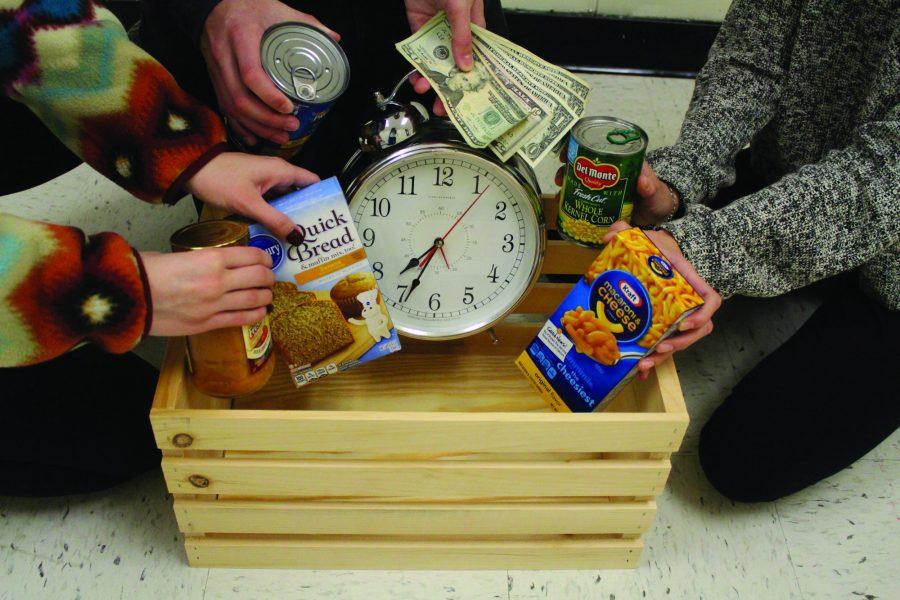Season of Warning: Take time to question charities’ credibility
Food for thought: Feed My Starving Children
A consistent history is one factor donors should look for when choosing a charity, according to Charity Navigator. The Christian non-profit organization Feed My Starving Children (FMSC) only puts 8-9% of their funds in administration and manufacturing, which is one reason they have earned their rating, says Alexander Cox, full time team leader at FMSC.
“[Charity Navigator] gave us a four star rating, which is their highest rating, for [almost eleven] years in a row now,” Cox said.
For being one of the smaller organizations, striving to eradicate hunger, FMSC’s high statistics further their reliability. This trustworthiness helps assure donors that their time volunteering to pack food really is reaching “the neediest children around the world,” according to fmsc.org.
“Our mission as an organization is to supply substantial, nutritious food sources as lifelines and about 99.7% of all food [has gotten] safely into the hands of our partners in the 29 years as an organization,” Cox said. “Anytime we promise food to an organization, we meet that promise. We have never reneged that kind of promise in the history of the organization.”
Not only may donors want to verify that their donations are getting into the right hands, but they may also want to look for consistent history in the organization’s spending, and FMSC is on top of that.
“It’s just 22 cents a meal. I know we’ve held that 22 cents or pretty close to it for about ten years now,” Cox said. “We’ve done our best to keep costs low and it enables us to push every dollar that comes into our door as far as it can go. We are staying pretty consistent in that and trying to maximize every dollar to feed as many kids as possible.”
Using statistics to display every dollar donors give is maximized allows for an additional indicator of a good charity; however, speaking to a member of a particular charity may aid donors in understanding their donations’ impact on a more personal level.
“Being a part of Feed My Starving Children [FMSC], for me, means that I’m a part of a tangible solution to an issue that’s much bigger than any of us think,” Cox said. “We’re just one part of a whole and just one part of the system. It’s a part of our mission statement to see hunger eradicated around the world so, for me, it just feels good to be a small part of the solution.”
Think before you pink: Susan G. Komen for the Cure
A significantly larger organization than FMSC, the Susan G. Komen for the Cure Foundation. has donated a large amount of time and money to Breast Cancer research, but have encountered criticism concerning donors in their past along the way. Yet Susan G. Komen is the most commonly known breast cancer charity.
“They’ve become so well-known, and it’s grown into a huge breast cancer research foundation,” Patty Monoson, a good friend of the late Susan G. Komen and member of the organization for over twelve years, said. “[The foundation] pays for grants to organizations that service women with Breast Cancer: covering screening, education, and transportation.”
Since the foundation’s origin in 1982, the foundation has become the world’s largest Breast Cancer organization and Monoson applauds them for holding this title.
“After every organization gets started it has a huge build up, like Komen did. I have to give them credit that they’ve sustained themselves and [have] a lot of [affiliates globally],” Monoson said.
The continuous growth of organizations may be another factor donors take into account before donating. Discontinuing Susan G. Komen’s growth as an organization, however, was about five years ago when the National Board of the foundation decided to defund any programs that offered abortions.
“I used to support it heavily: both financially and with personal effort,” Monoson said. “I absolutely still recommend people donate to them, I just personally can’t because their stance was political, negative, and inappropriate.”
Though many affiliates were lost and supporters became speculative due to this decision, according to Monoson, she was still impressed with the organization’s support in funding mammograms, tests, and surgeries, to women who couldn’t afford to have these necessary procedures done.
“I’m still pleased with the basis of what they’re doing,” Monoson said. “I still believe that they’re doing [what] they started out to do.”
Home is where the horse is: Partners for Progress
Every November, the annual Charity Bash events are kicked off to raise money for a charity that has been nominated by students. Students are required to choose a charity that has a strong connection to the high school and community; however, Student Council and club leaders are searching for more when choosing new charities each year that the entire school will support.
“We try to choose charities that we’re really passionate about and that we think the students will be passionate about,” Emma Wenckowski, Student Council President, said. “We don’t want to have people put in all this effort to raise money for a charity, then not have people excited about it, and then not raise a lot of money.”
The ability to stay in contact with organizations and to see the donations making a “real impact [is] one of the most rewarding” parts, according to Wenckowski.
“To me, it really makes what we’re doing more worthwhile because [with] a smaller charity, giving them thirty or forty thousand dollars is huge, but for a larger charity it’s just a drop in the bucket,” Wenckowski said. “[This way] we’re also able to build more personal ties with the charities.”
Although Wenckowski is able to see the impact with smaller charities more closely than with larger charities, she does not favor one size over the other and believes that having a basis as guidelines is what is more important in determining worth.
“How they’re using [the donations] makes them trustworthy [or not.] With a smaller charity I can see the person and have a personal conversation with them about what they’re specifically going to do with the money: that builds the trust,” Wenckowski. “That’s not saying that the larger the charity the worse work they’re doing though. I think having a vision, a plan, and a clear mission statement is what’s important to a good charity.”
Before slipping spare change into jars or donating to any cause, donors may want to investigate in order to assure that their donations are supporting reliable causes.

As a senior in her third year on staff, Megan (spelled the right way) will be taking on the role as Magazine Editor-in-Chief of Bear Facts Student Media....

